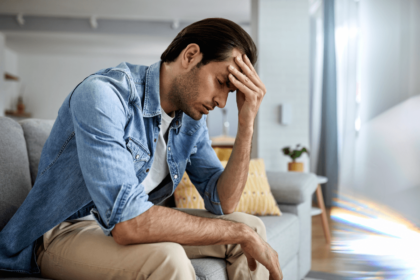Anxiety is a normal and adaptive response to stress or perceived threats.
when it becomes excessive or chronic, it can be problematic.
As the person with anxiety in unable to calm down.
Signs of Anxiety
Anxiety disorders, such as generalized anxiety disorder (GAD), social anxiety disorder, panic disorder, and others, are characterized by a range of emotional, cognitive, and physical symptoms.
Here are some of the common signs of anxiety:
Excessive Worry
People with anxiety often experience persistent and excessive worry about a wide range of everyday concerns, such as work, health, family, and finances.
This worry is often difficult to control or calm down and may feel overwhelming.
Restlessness
Anxiety can manifest as restlessness or an inability to relax or calm down.
Individuals may feel on edge, fidgety, and have difficulty sitting still.
Muscle Tension
Physical symptoms of anxiety often include muscle tension, leading to aches and pains, especially in the neck, shoulders, and back.
Fatigue
Constant worry and restlessness can lead to mental and physical exhaustion, even if a person hasn’t engaged in physically demanding activities.
Irritability
Anxiety can make people more irritable, short-tempered, and easily frustrated.
They may react more strongly to minor stressors, unable to calm down.
Difficulty Concentrating
Anxiety can interfere with a person’s ability to focus and concentrate on tasks.
Racing thoughts or preoccupation with worries can be distracting.
Sleep Disturbances
Many individuals with anxiety disorders experience sleep problems, such as difficulty falling asleep, staying asleep, or having restless and vivid dreams.
Rapid Heartbeat
Anxiety often leads to increased heart rate (tachycardia) and palpitations.
In some cases, this can lead to panic attacks.
Shortness of Breath
People with anxiety may feel as though they can’t catch their breath or have difficulty breathing, which can be a distressing symptom.
Sweating
Anxiety can lead to excessive sweating, even in non-stressful situations. This is often associated with an increase in body temperature.
Gastrointestinal Distress
Anxiety can affect the digestive system, leading to symptoms like stomachaches, nausea, diarrhea, or other gastrointestinal problems.
Excessive Worry About Physical Health
Some individuals with anxiety disorders may become preoccupied with fears about their physical health and may frequently visit doctors or medical professionals.
Avoidance Behavior
People with anxiety disorders may engage in avoidance behavior, which means they try to steer clear of situations, places, or activities that trigger their anxiety.
Panic Attacks
In the case of panic disorder, individuals may experience sudden and intense episodes of extreme fear or panic, often accompanied by physical symptoms like heart palpitations, sweating, trembling, and a sense of impending doom.
Social Isolation
Social anxiety disorder can lead to avoidance of social situations and isolation from others due to a fear of embarrassment or judgment.
Anxiety becomes a clinical concern when it is excessive, persistent, and interferes with a person’s daily life and functioning.
Calm Down in 5 Steps
Calmness is a state of inner peace and tranquility, and it’s something many people strive for, especially in the face of stress, anxiety, or overwhelming situations.
Learning how to calm down is a valuable skill that can help you regain control over your emotions and find balance in your life.
Here are five steps to help you calm down, explained in detail:
Step 1: Recognize Your Emotions
The first step to calm down is to recognize and acknowledge your emotions.
Often, our feelings are so intense that we may not be fully aware of what’s causing them.
Take a moment to pause and tune into your emotions.
Are you feeling anxious, angry, overwhelmed, or sad?
Understanding your emotional state is essential because it allows you to address the specific emotions that need attention.
Step 2: Deep Breathing and Mindfulness
Deep breathing and mindfulness techniques can be powerful tools for to calm down.
When you’re stressed or anxious, your body’s fight-or-flight response is triggered, leading to shallow and rapid breathing.
This, in turn, can intensify your emotional state.
Deep breathing helps counteract this by activating the body’s relaxation response.
To practice deep breathing, find a quiet, comfortable place to sit or lie down.
Close your eyes and take a slow, deep breath in through your nose, allowing your lungs to fill completely. Hold your breath for a few seconds, and then exhale slowly through your mouth.
Repeat this process several times, focusing on the sensation of your breath and letting go of racing thoughts.
Mindfulness involves paying attention to the present moment without judgment.
It can be as simple as concentrating on your breath, observing your surroundings, or focusing on bodily sensations.
By being fully present, you can detach from the racing thoughts that contribute to anxiety or stress.
Step 3: Progressive Muscle Relaxation
Progressive Muscle Relaxation (PMR) is a technique that helps reduce physical tension and calm down.
It involves systematically tensing and then relaxing different muscle groups in your body.
PMR helps you become more aware of physical tension and teaches your body to release it.
Start by finding a quiet, comfortable place to sit or lie down.
Begin at your toes and work your way up, one muscle group at a time.
Tense each muscle group for about 5-10 seconds and then release.
Pay attention to the sensations of tension and relaxation.
As you progress through your body, you’ll notice a sense of physical relief and relaxation.
This technique can help reduce physical symptoms of stress, such as muscle tension and a racing heart.
Step 4: Problem-Solving and Self-Reflection
If your anxiety or stress is rooted in a specific problem or situation, it can be helpful to engage in problem-solving and self-reflection.
Start by identifying the issue that’s causing your distress.
Once you’ve identified it, break it down into smaller, manageable components.
Consider potential solutions or strategies for addressing the problem.
Additionally, self-reflection can help you understand your emotional triggers and patterns.
Ask yourself why you’re feeling this way and whether there are recurring themes or triggers in your life.
Journaling can be a useful tool for self-reflection, as it allows you to explore your thoughts and emotions in depth.
Step 5: Reach Out and Connect
Sometimes, the most effective way to calm down is by seeking support from others.
Don’t hesitate to reach out to friends, family members, or a therapist when you’re feeling overwhelmed.
Sharing your feelings with someone you trust can provide emotional relief, validation, and a different perspective on the situation.
Connecting with others can also help distract you from your worries and offer a sense of comfort and companionship.
Social support is crucial for emotional well-being, and it can be a powerful antidote to stress and anxiety.
Learning how to calm down is a skill that can benefit your mental and emotional well-being.
These five steps – recognizing your emotions, deep breathing and mindfulness, progressive muscle relaxation, problem-solving and self-reflection, and reaching out and connecting with others – can guide you towards a state of calmness and equilibrium.
While these steps are valuable, remember that managing stress and anxiety is an ongoing process, and it’s essential to find techniques that work best for you and integrate them into your daily life.
Over time, you’ll become more proficient at calming yourself down and maintaining a sense of inner peace.
Pro Tips for Managing Anxiety
Managing anxiety is an important skill that can help improve your overall well-being.
Anxiety can be a normal response to stress, but when it becomes chronic or excessive, it can be debilitating.
Here are some tips for managing anxiety, each explained in detail:
Recognize and Accept Your Anxiety
The first step in managing anxiety is to acknowledge and accept that you are experiencing it.
Avoiding or denying your anxiety can make it worse.
Understand that anxiety is a natural human response to stress and perceived threats. By accepting it, you can begin to address it.
Practice Deep Breathing
Deep breathing is a powerful relaxation technique that can help calm your body’s stress response.
When you’re anxious, your breathing tends to become shallow and rapid.
To practice deep breathing, find a quiet place to sit or lie down.
Take slow, deep breaths through your nose, allowing your abdomen to rise as you inhale.
Hold your breath briefly, and then exhale slowly through your mouth.
Repeat this process several times, focusing on your breath and nothing else. This can help reduce the physical symptoms of anxiety.
Use Mindfulness Meditation
Mindfulness meditation involves paying attention to the present moment without judgment.
It can help you stay grounded and reduce racing thoughts.
Find a quiet, comfortable place, and focus on your breath, bodily sensations, or your immediate environment.
When your mind wanders, gently bring your focus back to the present. Over time, mindfulness can increase your awareness of your thought patterns and help you detach from anxious thoughts.
Challenge Negative Thoughts
Anxiety often involves irrational or negative thought patterns.
Challenge these thoughts by asking yourself if they are based on facts and evidence or if they are distorted by anxiety.
Consider alternative, more rational thoughts and try to reframe your perspective.
Cognitive-behavioral therapy (CBT) is a valuable approach that can help you identify and modify these thought patterns.
Establish a Routine
Creating a daily routine can provide a sense of structure and predictability, which can be comforting when dealing with anxiety.
Ensure your routine includes regular sleep, healthy meals, physical activity, and relaxation.
Having a structured day can reduce uncertainty and make it easier to manage anxiety.
Limit Caffeine and Alcohol
Caffeine and alcohol can exacerbate anxiety.
Caffeine is a stimulant that can increase restlessness and nervousness, while alcohol is a depressant that can disrupt your sleep and mood.
Reducing your consumption of these substances, especially in the evening, can help manage anxiety.
Get Regular Exercise
Regular physical activity can significantly reduce anxiety by promoting the release of endorphins, which are natural mood lifters.
Aim for at least 30 minutes of moderate exercise most days of the week.
Activities like walking, running, swimming, or yoga are excellent choices.
Prioritize Sleep
Quality sleep is essential for managing anxiety.
Develop good sleep hygiene practices, such as maintaining a consistent sleep schedule, creating a comfortable sleep environment, and avoiding screens before bedtime.
A well-rested mind and body are better equipped to cope with stress and anxiety.
Seek Professional Help
If your anxiety is severe or persistent, consider seeking help from a mental health professional.
Therapists can provide strategies and techniques tailored to your specific needs.
Medications may also be an option in some cases.
Remember that managing anxiety is a process that may require time and practice.
Experiment with these tips and find the combination of strategies that work best for you.
Be patient with yourself and seek professional guidance if needed.
With the right approach, you can effectively manage and reduce anxiety in your life, improving your overall quality of life.
Conclusion
understanding and effectively managing anxiety is an essential skill that can significantly improve your overall well-being and quality of life.
Anxiety is a natural response to stress and perceived threats, but when it becomes excessive or chronic, it can be challenging to cope with.
The signs of anxiety can manifest in various emotional, cognitive, and physical symptoms, impacting both your mental and physical health.
The article has discussed valuable strategies to help individuals calm down and regain control over their emotions when faced with anxiety.
These five steps, including recognizing your emotions, practicing deep breathing and mindfulness, progressive muscle relaxation, problem-solving and self-reflection, and reaching out to connect with others, serve as a comprehensive guide to achieving a state of inner peace and equilibrium.
Additionally, the pro tips for managing anxiety provide further insight into strategies that can help you effectively address and cope with anxiety.
Recognizing and accepting your anxiety, practicing deep breathing, using mindfulness meditation, challenging negative thoughts, establishing a daily routine, limiting caffeine and alcohol, incorporating regular exercise, prioritizing sleep, and seeking professional help when needed are all vital components of a well-rounded approach to managing anxiety.
It is essential to recognize that managing anxiety is an ongoing process, and there is no one-size-fits-all solution.
It may require time, practice, and patience to find the combination of techniques that work best for you. Seeking support from friends, family, or mental health professionals when needed is a sign of strength, not weakness, and can be a crucial step towards a more balanced and calm life.
By implementing these strategies and tips, individuals can navigate the challenges of anxiety, reduce its impact on their daily lives, and ultimately improve their overall well-being.
Remember that you have the capacity to take control of your anxiety and move towards a state of inner peace and tranquility.
FAQs
What is anxiety, and when does it become a concern?
Anxiety is a natural response to stress. It becomes a concern when it is excessive, persistent, and interferes with daily life.
What are the common signs of anxiety?
Common signs of anxiety include excessive worry, restlessness, muscle tension, fatigue, irritability, difficulty concentrating, sleep disturbances, rapid heartbeat, shortness of breath, sweating, and gastrointestinal distress.
How can I calm down when feeling anxious?
You can calm down by recognizing your emotions, practicing deep breathing and mindfulness, using progressive muscle relaxation, engaging in problem-solving and self-reflection, and reaching out to connect with others.
What role does a routine play in managing anxiety?
A daily routine provides structure and predictability, reducing uncertainty and helping manage anxiety.
How can I challenge negative thoughts associated with anxiety?
Challenge negative thoughts by evaluating their basis in facts, considering alternative rational thoughts, and using cognitive-behavioral therapy (CBT) techniques.
What are the effects of caffeine and alcohol on anxiety?
Caffeine and alcohol can exacerbate anxiety. Caffeine is a stimulant, and alcohol is a depressant, both affecting anxiety levels.
How can exercise help with anxiety?
Regular exercise promotes the release of endorphins, which are natural mood lifters, reducing anxiety.
When should I seek professional help for anxiety?
Seek professional help for severe or persistent anxiety. Therapists can provide tailored strategies, and medications may be an option in some cases.





